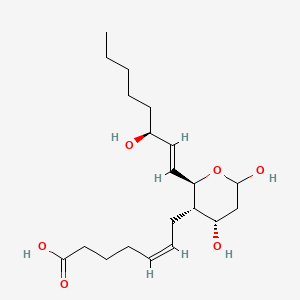Thromboxane b2
Thromboxane b2 is a lipid of Fatty Acyls (FA) class. Thromboxane b2 is associated with abnormalities such as endothelial dysfunction, Diabetes Mellitus, Non-Insulin-Dependent, Diabetes Mellitus, Ischemia and Thrombocytosis. The involved functions are known as Platelet Activation, Excretory function, Anabolism, Inflammation and mRNA Expression. Thromboxane b2 often locates in Endothelium, Hepatic and Microsomes, Liver. The associated genes with Thromboxane b2 are PTGS2 gene, prothrombin fragment 2 and CCL14 wt Allele.
Cross Reference
Introduction
To understand associated biological information of Thromboxane b2, we collected biological information of abnormalities, associated pathways, cellular/molecular locations, biological functions, related genes/proteins, lipids and common seen animal/experimental models with organized paragraphs from literatures.
What diseases are associated with Thromboxane b2?
Thromboxane b2 is suspected in endothelial dysfunction, Diabetes Mellitus, Non-Insulin-Dependent, Diabetes Mellitus, Ischemia, Thrombocytosis, Acute Coronary Syndrome and other diseases in descending order of the highest number of associated sentences.
Related references are mostly published in these journals:
| Disease | Cross reference | Weighted score | Related literature |
|---|
Possible diseases from mapped MeSH terms on references
We collected disease MeSH terms mapped to the references associated with Thromboxane b2
PubChem Associated disorders and diseases
What pathways are associated with Thromboxane b2
There are no associated biomedical information in the current reference collection.
PubChem Biomolecular Interactions and Pathways
Link to PubChem Biomolecular Interactions and PathwaysWhat cellular locations are associated with Thromboxane b2?
Visualization in cellular structure
Associated locations are in red color. Not associated locations are in black.
Related references are published most in these journals:
| Location | Cross reference | Weighted score | Related literatures |
|---|
What functions are associated with Thromboxane b2?
Related references are published most in these journals:
| Function | Cross reference | Weighted score | Related literatures |
|---|
What lipids are associated with Thromboxane b2?
There are no associated biomedical information in the current reference collection.
What genes are associated with Thromboxane b2?
Related references are published most in these journals:
| Gene | Cross reference | Weighted score | Related literatures |
|---|
What common seen animal models are associated with Thromboxane b2?
There are no associated biomedical information in the current reference collection.
NCBI Entrez Crosslinks
All references with Thromboxane b2
Download all related citations| Authors | Title | Published | Journal | PubMed Link |
|---|---|---|---|---|
| Hirsh PD et al. | Influence of blood sampling site and technique on thromboxane concentrations in patients with ischemic heart disease. | 1982 | Am. Heart J. | pmid:7102506 |
| Smith EF and Lefer AM | Stabilization of cardiac lysosomal and cellular membranes in protection of ischemic myocardium due to coronary occlusion:efficacy of the nonsteroidal anti-inflammatory agent, naproxen. | 1981 | Am. Heart J. | pmid:7211667 |
| Nakashima Y et al. | Sustained-release nifedipine (nifedipine-L) suppresses plasma thromboxane B2 and 6-keto prostaglandin F1 alpha in both young male smokers and nonsmokers. | 1990 | Am. Heart J. | pmid:2353613 |
| Ikonomidis I et al. | Cigarette smoking is associated with increased circulating proinflammatory and procoagulant markers in patients with chronic coronary artery disease: effects of aspirin treatment. | 2005 | Am. Heart J. | pmid:15894964 |
| Nitz RE and Martorana PA | The activity of molsidomine in experimental models of ischemic cardiac disease. | 1985 | Am. Heart J. | pmid:3919549 |
| Buchanan MR et al. | Effect of nafazatrom on platelet function and release: relationship to symptomatic episodes in patients with peripheral vascular disease. | 1987 | Am. Heart J. | pmid:2953219 |
| De Caterina R et al. | Inhibition of platelet function during in vivo infusion of isosorbide mononitrates: relationship between plasma drug concentration and hemodynamic effects. | 1990 | Am. Heart J. | pmid:2321506 |
| Buerke M et al. | Aspirin therapy: optimized platelet inhibition with different loading and maintenance doses. | 1995 | Am. Heart J. | pmid:7661062 |
| Mehta J et al. | Thromboxane release in coronary artery disease: spontaneous versus pacing-induced angina. | 1984 | Am. Heart J. | pmid:6695662 |
| Cotter G et al. | Lack of aspirin effect: aspirin resistance or resistance to taking aspirin? | 2004 | Am. Heart J. | pmid:14760328 |
| Mehta J and Mehta P | Prostacyclin and thromboxane A2 production by human cardiac atrial tissues. | 1985 | Am. Heart J. | pmid:3880988 |
| Friedrich T et al. | Follow-up of prostaglandin plasma levels after acute myocardial infarction. | 1985 | Am. Heart J. | pmid:3880994 |
| O'Connor KM et al. | The effect of thromboxane inhibition on vulnerability to ventricular fibrillation in the acute and chronic feline infarction models. | 1989 | Am. Heart J. | pmid:2929400 |
| Zhu BQ and Parmley WW | Modification of experimental and clinical atherosclerosis by dietary fish oil. | 1990 | Am. Heart J. | pmid:2105047 |
| Neri Serneri GG et al. | Abnormal cardiocoronary thromboxane A2 production in patients with unstable angina. | 1985 | Am. Heart J. | pmid:3984828 |
| Roy L et al. | Lack of efficacy of nafazatrom, a novel anti-thrombotic compound, in patients with coronary artery disease. | 1985 | Am. Heart J. | pmid:3158183 |
| Yamada Y et al. | Possible mechanism of vascular reocclusion after initially successful thrombolysis with recombinant tissue-type plasminogen activator. | 1991 | Am. Heart J. | pmid:1903579 |
| FitzGerald GA et al. | Cigarette smoking and hemostatic function. | 1988 | Am. Heart J. | pmid:3276116 |
| Jouve R et al. | Thromboxane B2, 6-keto-PGF1 alpha, PGE2, PGF2 alpha, and PGA1 plasma levels in arteriosclerosis obliterans: relationship to clinical manifestations, risk factors, and arterial pathoanatomy. | 1984 | Am. Heart J. | pmid:6581715 |
| Rebuzzi AG et al. | Importance of reperfusion on thromboxane A2 metabolite excretion after thrombolysis. | 1992 | Am. Heart J. | pmid:1539506 |
